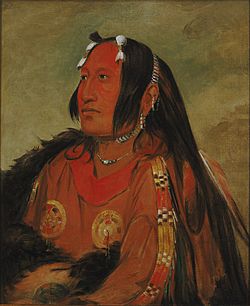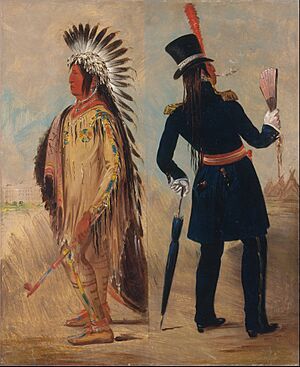Wi-jún-jon facts for kids
Quick facts for kids
Pigeon's Egg Head
|
|
|---|---|
| Wi-jún-jon | |

Portrait by George Catlin, 1831
|
|
| Assiniboine leader | |
| Personal details | |
| Born | 1796 |
| Died | 1872 |
| Nickname | The Light |
Wi-jún-jon, also known as Pigeon's Egg Head or The Light, was an important Native American chief. He was born in 1796 and passed away in 1872. Wi-jún-jon belonged to the Assiniboine tribe, who lived in the vast Great Plains region.
He is most famous for being the subject of a special painting by an artist named George Catlin. This painting shows Wi-jún-jon in two different ways. On one side, he is seen in his traditional tribal clothing. On the other side, he is shown wearing clothes common in America at that time. This change happened after he visited Washington, D.C. in 1832.
Contents
A Chief's Journey to Washington
In 1832, Wi-jún-jon traveled a long way to Washington, D.C. This trip was a big event for him and his tribe. It was a chance to meet with government leaders. During his visit, he experienced a very different way of life.
The Transformation in Appearance
Artist George Catlin captured Wi-jún-jon's journey in a famous painting. The painting shows how Wi-jún-jon's appearance changed. Before his trip, he wore the beautiful, traditional clothes of the Assiniboine people. These clothes were often decorated with care.
After his visit, Wi-jún-jon started to wear a different kind of outfit. Catlin described him wearing a fine blue suit with gold trim. He also wore large shoulder decorations called epaulets. His neck was tightly held by a black stock, and he wore waterproof boots with high heels. This new look was very different from his traditional clothing.
What is Cultural Assimilation?
Wi-jún-jon's change in clothing is an example of cultural assimilation. This is when a person or a group starts to adopt the customs, clothing, or ways of life of another culture. For Wi-jún-jon, it meant changing his outward appearance to fit in with the American style of the time. This was a common experience for many Native American leaders who visited cities like Washington, D.C.
The Popularity of the Painting
The painting of Wi-jún-jon became very well-known. A print was made from the painting. It showed him both in his Assiniboine dress and in his Western suit. The print was titled Wi-jún-jon, Pigeon's Egg Head, Going to Washington, returning to his house.
This print became quite popular. It even appeared in a German magazine called Die Gartenlaube in 1853. This shows how much interest there was in Native American culture and the changes happening at that time.


